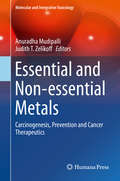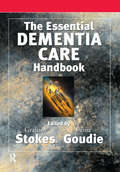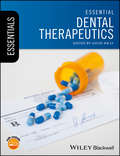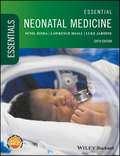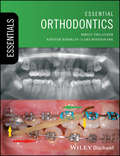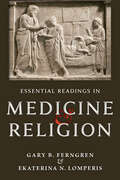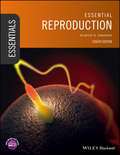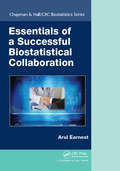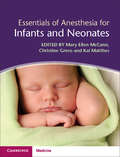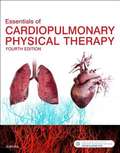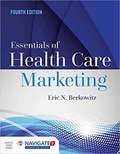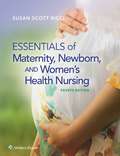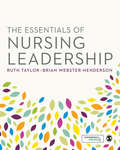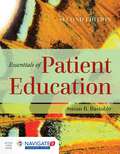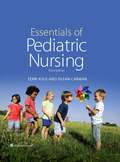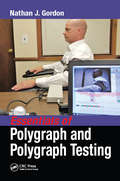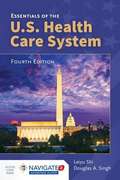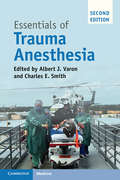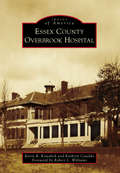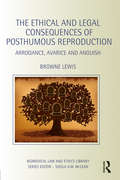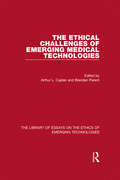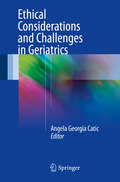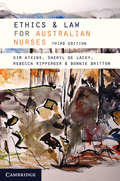- Table View
- List View
Essential and Non-essential Metals
by Anuradha Mudipalli Judith T. ZelikoffThis book aims to present current state of understanding of the role of metals in human health and disease. As it will be difficult to cover all of the metals, about two scores of them, the authors will instead provide a detailed analysis of a select set of essential (Calcium, Magnesium, Selenium, Iron, copper and Zinc) and non-essential metals (Nickel, Chromium, Cadmium and Arsenic, Tungsten and Asbestos). Each chapter will have a dedicated section focusing on the binary role that some of these metals play, their carcinogenic and cancer therapeutics, by integrating epidemiological, experimental evidence with special emphasis and focus on molecular mechanisms involved in these processes. The biological analysis will also include emerging lines of evidence such as micro RNAS, kinase families, receptors, endoplasmic, mitochondrial players and epigenetics. As part of integrating the human, experimental and mechanistic data, as well as a detailed analysis into the modes of action for different cancer outcomes will be discussed in each chapter wherever deemed feasible. These approaches are ones in which no other book in this area has attempted to do.
The Essential Dementia Care Handbook: A Good Practice Guide
by Fiona GoudieReplacing the successful "Working with Dementia", this edition draws together many new ideas and practical approaches from a wide variety of professionals working at the leading edge of the provision of services to people with dementia and provides a comprehensive account of current best practice. Beginning with the diagnosis of dementia and other problems associated with aging, this book considers assessment, the person centered model of dementia, rehabilitation and therapy. It outlines practical interventions, illustrated with case studies that provide a stimulating insight into contemporary understanding and practice. Nursing staff, occupational therapists, residential care workers, social workers and all those in day-to-day contact with elderly people will be inspired by this vital handbook for all care staff.
Essential Dental Therapeutics
by David WrayEssential Dental Therapeutics is a practical guide to drugs and their effects on dental care. Covering both medical and dental prescribing, all major categories of prescription drugs, their possible side effects, and potential drug interactions are discussed. The medical section is succinct and easily understandable, providing busy dentists with the information they need about medical conditions and the drugs used to treat them. The dental section offers practical, straightforward information that is relevant to everyday dental prescribing. All clinical contributing authors are medically and dentally trained, and both strands are fully integrated throughout the text. Readers can test their knowledge by using the key topics and learning objectives at the start of each chapter, and by accessing the companion website featuring self-assessment questions. Essential Dental Therapeutics is a practical reference for dental students and practitioners, ensuring they are safe and informed in everyday practice.
Essential Neonatal Medicine
by Lawrence Miall Luke Jardine Sunil SinhaProviding a comprehensive yet concise guide for trainee doctors, neonatal nurses and midwives, Essential Neonatal Medicine continues to be an indispensable resource that combines the depth and breadth of a textbook with the efficiency of a revision guide. Extensively updated and full-colour throughout, this edition includes new chapters on neonatal transport and palliative care, as well as further content on pathophysiology and embryology, quality improvement and risk management, infection control, and non-invasive ventilation. With an improved artwork programme and a new glossary of terms, Essential Neonatal Medicine is ideal for all trainee health professionals new to neonatology, or looking for a comprehensive aid to support them.
Essential Orthodontics
by Birgit Thilander Krister Bjerklin Lars BondemarkEssential Orthodontics is a comprehensive introduction to the biological principles of orthodontics. This book covers the why, when and how of orthodontics, enabling readers to identify which individuals need to be treated, to diagnose based on individual dentofacial development, and to understand the mechanical principles and tissue responses involved. Divided into three parts, this authoritative resource covers pretreatment considerations, treatment principles of skeletal and dentoalveolar anomalies, and tissue response to orthodontic and orthopaedic forces. Classification of malocclusions and craniofacial growth and development are discussed, and the text explores how to distinguish between normal occlusion and malocclusions. Essential Orthodontics outlines how to perform a comprehensive orthodontic examination leading to an orthodontic diagnosis, and the formation of a treatment plan. Following a student-friendly layout with key objectives and chapter summaries, Essential Orthodontics is an accessible yet comprehensive resource for both undergraduate and postgraduate dental students.
Essential Readings in Medicine and Religion
by Gary B. Ferngren Ekaterina N. LomperisAn indispensible collection of sources chronicling the relationship between medicine and religion from ancient to modern times.Gary B. Ferngren and Ekaterina N. Lomperis have gathered a rich collection of annotated primary sources that illustrate the intersection of medicine and religion. Intended as a companion volume to Ferngren’s classic Medicine and Religion, which traces the history of the relationship of medicine to religion in the Western world from the earliest ancient Near Eastern societies to the twenty-first century, this useful and extensive sourcebook places each key document in historical context.Drawing from more than 160 texts, the book explores a number of themes, including concepts of health, the causes and cure of disease, medical ethics, theodicy, beneficence, religious healing, consolation, and death and dying. Each chapter begins with an introduction that furnishes a basic historical setting for the period covered. Modern translations, some of which have been made especially for this volume, are used whenever possible. The texts are numbered sequentially within each chapter and preceded by a short introduction to both the author and the subject.Touching on Mesopotamia, Egypt, Israel, Greece, Rome, the European Middle Ages, Islam, early modern Europe, and the modern era, Essential Readings in Medicine and Religion brings a wide range of sources together to expand on the crucial lessons of Medicine and Religion. This book is a useful introduction for all students of history, divinity, medicine, and health.
Essential Readings in Medicine & Religion
by Gary B. Ferngren Ekaterina N. Lomperis“[A] useful, well-edited anthology of important texts in the history of the intersection of religion and medicine.” —Warren Kinghorn, MD, ThD, Duke University Medical Center and Duke Divinity SchoolGary B. Ferngren and Ekaterina N. Lomperis have gathered a rich collection of annotated primary sources that illustrate the intersection of medicine and religion. Intended as a companion volume to Ferngren’s classic Medicine and Religion, which traces the history of the relationship of medicine to religion in the Western world from the earliest ancient Near Eastern societies to the twenty-first century, this useful and extensive sourcebook places each key document in historical context.Drawing from more than 160 texts, the book explores a number of themes, including concepts of health, the causes and cure of disease, medical ethics, theodicy, beneficence, religious healing, consolation, and death and dying. Each chapter begins with an introduction that furnishes a basic historical setting for the period covered. Modern translations, some of which have been made especially for this volume, are used whenever possible. The texts are numbered sequentially within each chapter and preceded by a short introduction to both the author and the subject.Touching on Mesopotamia, Egypt, Israel, Greece, Rome, the European Middle Ages, Islam, early modern Europe, and the modern era, Essential Readings in Medicine and Religion brings a wide range of sources together to expand on the crucial lessons of Medicine and Religion. This book is a useful introduction for all students of history, divinity, medicine, and health.
Essential Reproduction (Essentials)
by Martin H. JohnsonEssential Reproduction provides an accessible account of the fundamentals of reproduction within the context of cutting-edge knowledge and examples of its application. The eighth edition of this internationally best-selling title provides a multidisciplinary approach integrating anatomy, physiology, genetics, behaviour, biochemistry, molecular biology and clinical science, to give thorough coverage of the study of mammalian reproduction. Key features: Contains discussion of the latest on conceptual, informational and applied aspects of reproduction New pedagogical features such as clinical case studies at the end of each chapter Better use of boxed material to improve separation of narrative text from ancillary information Highlighted key words for ease of reference relate to summary of key points Introduction now split into two sections Expanded content in Fetal challenges, and Society and reproduction Substantial rearrangement and updating in Making sperm, Controlling fertility, and Restoring fertility
Essentials of a Successful Biostatistical Collaboration (Chapman & Hall/CRC Biostatistics Series)
by Arul EarnestThe aim of this book is to equip biostatisticians and other quantitative scientists with the necessary skills, knowledge, and habits to collaborate effectively with clinicians in the healthcare field. The book provides valuable insight on where to look for information and material on sample size and statistical techniques commonly used in clinical research, and on how best to communicate with clinicians. It also covers the best practices to adopt in terms of project, time, and data management; relationship with collaborators; etc.
Essentials of Anesthesia for Infants and Neonates
by Mary Ellen McCann Christine Greco Kai MatthesIt is estimated that 1.5 million infants undergo surgery and anesthesia in the USA each year. However, there are serious concerns within the pediatric anesthesia community regarding the safety of anaesthesia in infants and children. There is mounting evidence from animal studies that anesthetics in common clinical use are neurotoxic to the developing brain and cause long-term neurobehavioral abnormalities. Essentials of Anesthesia for Infants and Neonates provides a comprehensive guide to the special needs of infants undergoing anesthesia. It focuses on the first year of life, the time when anesthesia mortality and morbidity is highest. Chapters are illustrated in color throughout, and include sections on newborn physiology for anesthetic management, specific procedures, pain management, and topics such as regional anesthesia and sedation. Written by nationally recognized experts, this book will become an invaluable point of reference for any physician interested in pain management in the first year of life. Delivers comprehensive practical information on techniques to administer neonatal and infant anesthesia; Focuses in on the youngest, most fragile patients, allowing readers to tailor their anesthetics to this age group; Reviews and critiques anesthetic neurotoxicity in young children, discussing methods to limit exposure to neurotoxic agents.
Essentials Of Cardiopulmonary Physical Therapy (Fourth Edition)
by Ellen HillegassImprove your understanding of the cardiopulmonary system with Essentials of Cardiopulmonary Physical Therapy, 4th Edition. Based on best practices prescribed in The Guide to Physical Therapist Practice, this new edition provides comprehensive coverage of anatomy, physiology, and cardiopulmonary assessment, along with expanded chapters on the growing topics of early mobilization of the ICU patient and acute care management. Using a practical approach, expert author Ellen Hillegass also discusses pathophysiology, pharmacology, and interventions in the outpatient setting. <p><p> Evidence-based content reflects the latest research in the field and incorporates the use of ICF. Material uses best practices defined by the American Physical Therapy Association. Clinical tips give you real-world hints and suggestions from practicing clinicians. <p> NEW! Expanded chapters cover early mobilization of the ICU patient and acute care management. <p> NEW! Updated references emphasize evidence-based information from the text. <p> NEW! Full-color printing enhances text.
Essentials Of Health Care Marketing
by Eric N. BerkowitzNew Fifth Edition of Essentials of Health Care Marketing coming in March 2021. The healthcare industry continues to undergo enormous changes with new laws and policies, fresh innovations, and an increasingly educated health consumer. As such, healthcare administrators must be prepared to shift their strategies in order to meet the demands of this dynamic market. Essentials of Health Care Marketing, Fourth Edition will provide your students with a foundational knowledge of the principles of marketing and their particular application in health care. Moreover, the text offers a perspective on how these principles must shift in response to the changing environmental forces that are unique to this market. This complete curriculum of marketing management tools and techniques is ideal for graduate courses, though advanced undergraduates can readily grasp the level of presentation. New to the Fourth Edition: Chapter 3 (Environment) heavily revised to include new health care delivery models, increased competition, foreign competitors, and health care reform. Chapter 4 now includes discussion of exchanges. Chapter 10 addresses increasing amount of system consolidation.
Essentials of Maternity, Newborn, and Women's Health Nursing (Fourth Edition)
by Susan RicciHelp your students prepare for effective maternity nursing practice! This updated 4th Edition of Susan Ricci’s practical text provides students with the essential information they need to care for women and their families, and also to assist them in making the right choices safely, intelligently, and with confidence. With integrated case studies and nursing procedures throughout, the text takes a nursing process approach, builds on previously mastered content, and includes much that is new, including increased coverage of the cultural and global aspects of maternity and women’s health care. <P><P>KEY FEATURES <ul> <li>Revised Unfolding Case Studies in every chapter, now paired with patient photos, give students an opportunity to apply concepts to real-life scenarios.</li> <li>Up-to-date Nursing Procedures provide clear, step-by-step explanations, along with illustrations of variations in nursing care, to help students master vital skills.</li> <li>New Bringing It All Together Case Studies begin in the end-of-chapter worksheets and unfold online, providing extended opportunities for students to connect learning to practice.</li> <li>New! Concept Mastery Alerts improve students’ understanding of potentially confusing topics as identified by Lippincott’s Adaptive Learning Powered by PrepU.</li> <li>Updated Teaching Guidelines, now with rationales, prepare students to educate families.</li> <li>Additional evidence-based research findings promote evidence-based maternity nursing practice and interventions.</li> <li>More than 700 NCLEX-Style Review Questions help students review important concepts and prepare for the NCLEX-RN.</li> </ul> <P><P>This leading content is also incorporated into Lippincott CoursePoint+, a dynamic learning solution that integrates this book’s curriculum, adaptive learning tools, virtual simulations, real-time data reporting, and the latest evidence-based practice content together into one powerful student learning solution. Lippincott CoursePoint+ improves the nursing students’ critical thinking and clinical reasoning skills to prepare them for practice. Learn more at www.NursingEducationSuccess.com/CoursePoint.
The Essentials of Nursing Leadership
by Ruth Taylor Brian Webster-HendersonThis new approach to leadership focuses on how students can develop leadership skills right from the start of their nursing programme through to transitioning to their first role. The book first takes students through the underpinning knowledge and theory and then through practical skills to help them understand all aspects of leadership and how it is a key component of providing quality care to patients in a range of environments and settings. Real stories from nursing leaders, practitioners and students are included to inspire students and show them how they can impact positively on practice, whatever level they are working at. Key features include: Real life focus, grounded in everyday practice, with lots of case studies and examples to help students see how theory relates to practice Activities to help students reflect about their own practice, and about themselves as leaders Video interviews with nurse leaders and students on the companion website Further reading and links to journal articles in both the book and the companion website help students delve deeper and prepare for assessments.
The Essentials of Nursing Leadership
by Ruth Taylor Brian Webster-HendersonThis new approach to leadership focuses on how students can develop leadership skills right from the start of their nursing programme through to transitioning to their first role. The book first takes students through the underpinning knowledge and theory and then through practical skills to help them understand all aspects of leadership and how it is a key component of providing quality care to patients in a range of environments and settings. Real stories from nursing leaders, practitioners and students are included to inspire students and show them how they can impact positively on practice, whatever level they are working at. Key features include: Real life focus, grounded in everyday practice, with lots of case studies and examples to help students see how theory relates to practice Activities to help students reflect about their own practice, and about themselves as leaders Video interviews with nurse leaders and students on the companion website Further reading and links to journal articles in both the book and the companion website help students delve deeper and prepare for assessments.
Essentials of Patient Education
by Susan B. BastableEach new print copy includes Navigate 2 Advantage Access that unlocks a comprehensive and interactive eBook, student practice activities and assessments, a full suite of instructor resources, and learning analytics reporting tools. Essentials of Patient Education, Second Edition prepares nurses for their increasing role in patient teaching, health education and health promotion. Highly revised, the Second Edition focuses on the basic principles of teaching and learning by emphasizing the role of the professional nurse in educating patients and families effectively and efficiently in various healthcare settings. The Second Edition explores new topics of motor learning and gender differences in the brain as well as, the ethics of patient education and the legal role of the nurse as mandated by state practice. The text features completely revised chapter content and updated references that provide evidence from research and theoretical foundations which substantiate content throughout the text. Key Features: Coverage of health literacy Chapters dedicated to gender, socioeconomics, culture and persons with disabilities Discussion of compliance and motivation issues Includes the determinants of learning which captures critical information on the learner Case studies offer the opportunity to apply the teaching and learning principles featured in the chapter Instructor Resources: Lecture outlines in PowerPoint format Learning Activities Assessments
Essentials of Pediatric Nursing, 3rd Edition
by Theresa Kyle Susan CarmanEssentials of Pediatric Nursing is intended for Pediatric Nursing courses with an integrated pediatric curriculum. It provides a unique concept-based approach and nursing process focus that helps students go from concept to application by building on previously mastered knowledge from other courses. The new edition of the text focuses on allowing students to apply concepts from the book to cases throughout the book. It also emphasizes developmental considerations and atraumatic care, illustrating the unique nature of a pediatric patient. Also new to this edition are highlighted sections, showing student,,s key areas in the text that students commonly struggle with and real life critical thinking exercises. This edition will have a comprehensive supplements program to support faculty and student needs, in addition to a pediatric nursing videos series available on thePoint. Features: Hallmark Features and Key Revisions/Update: New: Misconception Alert, Boxes focusing on items that "students often misunderstand", drawn from PrepU. Feature subtly branded to PrepU. Aim to help students focus. , New: Dose Calc Box, Dose Calculation Boxes: Keeping the focus on differences between adult and child patients at the front of student,,s minds. , New: End of Chapter Case, End of chapter case study to apply course content. Phase I of case is in the book and entire unfolding case study is on thePoint. Linking print/digital. , New: Bringing it all Together, Segment drawing content application from from multiple chapters, to develop dynamic/critical thinking. Including prioritization, development, etc. To be located at end of chapters for all of unit 4. , Update: Threaded/Unfolding Case, Making note of the 'unfolding case,,, at each feature occurrence, throughout each chapter and aligning photo in chapter opener to small photo assigned with threaded case to make feature more visible to students. , Update: Worksheet, Including a question focusing on dosage calculation in the worksheet, Update: Developmental Considerations, Adding more developmental considerations throughout the book to help students understand the importance/difference between children/adults, Update: Key Terms, Putting more advanced terms in this section of the book, Update: Teaching Guidelines, Making these briefer and adjusting formatting for brevity, Update: Consider This, Guidelines on thePoint for answers/guidance on how to reach answers with page numbers, Visual preface, Preface to have visual walk through of key features,
Essentials of Polygraph and Polygraph Testing
by Nathan J. GordonThroughout history, there has been an intrinsic need for humans to detect deception in other humans. Developed in 1923, the polygraph machine was a tool designed to do just this. To date, there have been many improvements made to the basic polygraph instrument. This book outlines the instrumentation as well as the latest in questioning techniques and methods available to the professional interviewer to determine truth from deception. The book covers psychology and physiology, a history of polygraph with the advances of leading figures, question formulation, data analysis, legal implications and legal cases, and the author’s developed technique Integrated Zone Comparison Technique (IZCT).
Essentials of the U. S. Health Care System
by Leiyu Shi Douglas A. SinghEssentials of the U.S. Health Care System, Fourth Edition is a clear and concise distillation of the major topics covered in the best-selling Delivering Health Care in America by the same authors. Designed for undergraduate and graduate students in programs across the health disciplines, Essentials of the U.S. Health Care System is a reader-friendly, well organized resource that covers the major characteristics, foundations, and future of the U.S. health care system. The text clarifies the complexities of health care organization and finance and presents a solid overview of how the various components fit together. <P><P>Readers will gain the necessary tools to understand the unique dynamics of the U.S. health care system, including health care delivery, public policy, and the placement of the U.S. health care system within the larger context of global health care.
Essentials of Trauma Anesthesia
by Albert J. Varon Charles E. SmithCovering the most important topics in trauma anesthesia, this updated edition provides anesthesiology trainees and practitioners with a practical basis for managing trauma patients. Many recent advances in trauma care are identified, including paradigm shifts in the management of bleeding and coagulopathy, new neuromuscular blockade and anticoagulant reversal drugs, and updated clinical practice guidelines. This volume provides a concise, practical review of the essential elements in the care of the severely injured trauma patient, including emergency airway management, fluid and blood resuscitation, monitoring, coagulation therapy, regional and general anesthesia, and perioperative care. Edited by two of the most experienced trauma anesthesiologists in the USA, with chapters written by experts from leading US and Canadian trauma centers with the highest and most varied caseload of critically injured patients, Essentials of Trauma Anesthesia identifies new trends in surgery and anesthesiology practices that impact on the management of trauma patients. Includes the most important topics in trauma anesthesia, providing anesthesiologists with a solid foundation for managing trauma. Offers a concise review of the essential elements in the care of the severely injured trauma patient. Identifies new trends in surgery and anesthesiology practices that impact the management of trauma patients, including echocardiography and regional anesthesia.
Essex County Overbrook Hospital (Images of America)
by Robert L. Williams Kevin R. Kowalick Kathryn CataldoWhat was founded as the Essex County Lunacy Asylum evolved from a single building on South Orange Avenue to a city within itself in Cedar Grove. It was named the Essex County Overbrook Hospital. Construction began on the hospital's iconic brick buildings in 1896, and they were prominent features on Fairview Avenue for the next 100 years. The facility produced its own food, housed its own police and fire departments, and sustained its own power sources. The Essex County Overbrook Hospital was recognized throughout the world as a leader in psychiatric care. In later years, overcrowding began to plague the institution. However, after the advent of modern psychiatric drugs, many patients were able to be discharged back into the community. In 2007, the buildings were closed, and the hospital was relocated to a newer establishment nearby. The grounds have since been plagued with vandalism and neglect, with a final deal for demolition having been solidified in 2015.
The Ethical and Legal Consequences of Posthumous Reproduction: Arrogance, Avarice and Anguish (Biomedical Law and Ethics Library)
by Browne LewisPosthumous reproduction refers to the procedure that enables a child to be conceived using the gametes of a dead person. Advances in reproductive technology mean it is now possible to assist in creating a life after you die, and in recent years the number of women who have attempted to get pregnant using posthumous reproduction has increased. However, the law in many jurisdictions has not put regulations in place to deal with the ethical and legal consequences that arise as a result of posthumous reproduction. This is the first book to exclusively focus on posthumous reproduction. The book comprehensively explores the legal and ethical issues surrounding posthumous reproduction in a number of jurisdictions including the US, Israel, the UK and France. The book looks at a number of issues including: ascertaining the wishes of the dead and protecting the reproductive rights of men who have deposited frozen sperm in clinics prior to their deaths; cases involving people who want to acquire fresh sperm from deceased or incompetent men and determining who should have the right to accept the sperm; identifying the parents of the posthumously conceived child; and discussing the need to promote the best interests of the child. The book critically examines the current laws that are in place and proposes additional regulations and policies in order to effectively regulate posthumous reproduction.
The Ethical Challenges of Emerging Medical Technologies (The\library Of Essays On The Ethics Of Emerging Technologies Ser.)
by Arthur L. Caplan Brendan ParentThis collection of essays emphasizes society’s increasingly responsible engagement with ethical challenges in emerging medical technology. Expansion of technological capacity and attention to patient safety have long been integral to improving healthcare delivery but only relatively recently have concepts like respect, distributive justice, privacy, and autonomy gained some power to shape the development, use, and refinement of medical tools and techniques. Medical ethics goes beyond making better medicine to thinking about how to make the field of medicine better. These essays showcase several ways in which modern ethical thinking is improving safety, efficacy and efficiency of medical technology, increasing access to medical care, and empowering patients to choose care that comports with their desires and beliefs. Included are complimentary ethical approaches as well as compelling counter-arguments. Together, the articles demonstrate how improving the quality of medical technology relies on every stakeholder -- not just medical researchers and scientists -- to assess each given technology’s strengths and pitfalls. This collection also portends one of the next major issues in the ethics of medical technology: developing the requisite moral framework to accompany shifts toward patient-centred personalized healthcare.
Ethical Considerations and Challenges in Geriatrics
by Angela Georgia CaticThis book is designed to present an overview of common geriatrics ethical issues that arise during patient care and research activities. Each chapter includes a case example and practical learning pearls that are useful in day-to-day patient care. Coverage includes a brief overview of geriatric epidemiology, highlighting the high rates of dementia, use of surrogate decisions makers at the end-of-life, relocation from home to long-term care facilities, and low health literacy in the geriatrics population. Sections are devoted to issues around capacity, surrogate decision making, end-of-life care, hemodialysis in the elderly, and futility as well as challenges presented by independence questions, such as dementia care, driving, feeding, and intimacy in nursing homes. The text also addresses questions around recognizing, reporting, and treating elder abuse and self-neglect, ethics related to research and technology in the geriatric population, and the use of e-mail, Facebook, and open notes. Written by experts in the field, Ethical Considerations and Challenges in Geriatrics is a valuable tool for trainees at a variety of levels including medical students, residents, and fellows. In addition, it provides practical guidance and a useful reference for practicing geriatricians, primary care physicians, geriatric nurses, social workers, nursing home workers, hospice care employees, and all medical health professionals working with the elderly.
Ethics and Law for Australian Nurses
by Kim Atkins Bonnie Britton De Lacey Sheryl Rebecca RippergerThe third edition of Ethics and Law for Australian Nurses develops an innovative practical framework for understanding the ethical and legal dimensions of nursing practice in Australia. Taking a 'relational' approach to practice, the text foregrounds the concepts of personhood, vulnerability and the nurse-patient relationship as the source of a nurse's moral and legal obligations. This approach is central to the book's discussion of key ethical and legal concepts throughout the text including consent and autonomy, negligence and liability, confidentiality and trust, and culturally safe practice. This edition has been thoroughly revised to include the latest research and methods, updated legislation and links to professional documentation, along with a new chapter on aged care. Student learning is supported by case studies, legal case extracts and learning exercises. A new instructor companion website features a curated suite of multimedia resources and extension questions.
